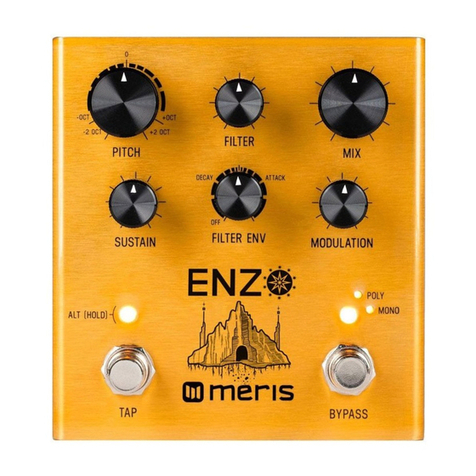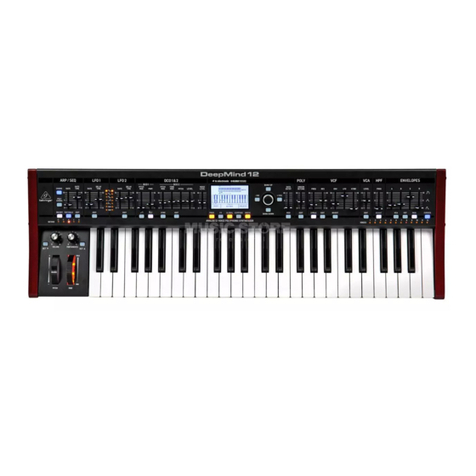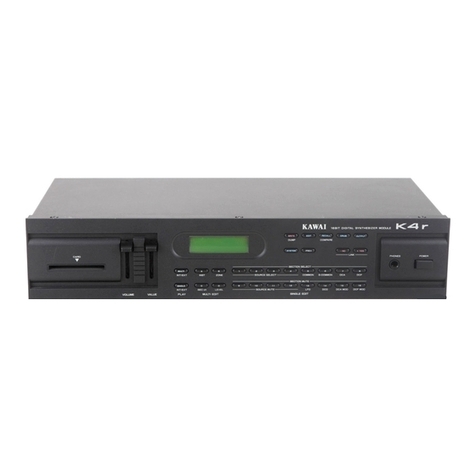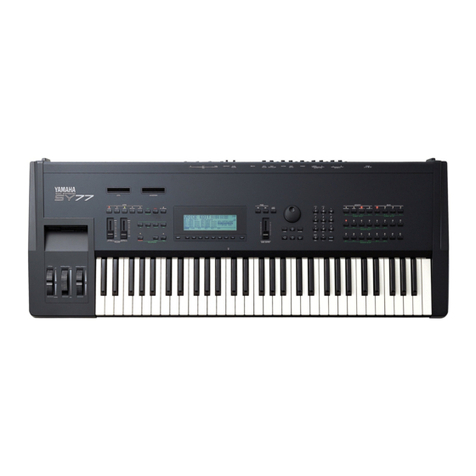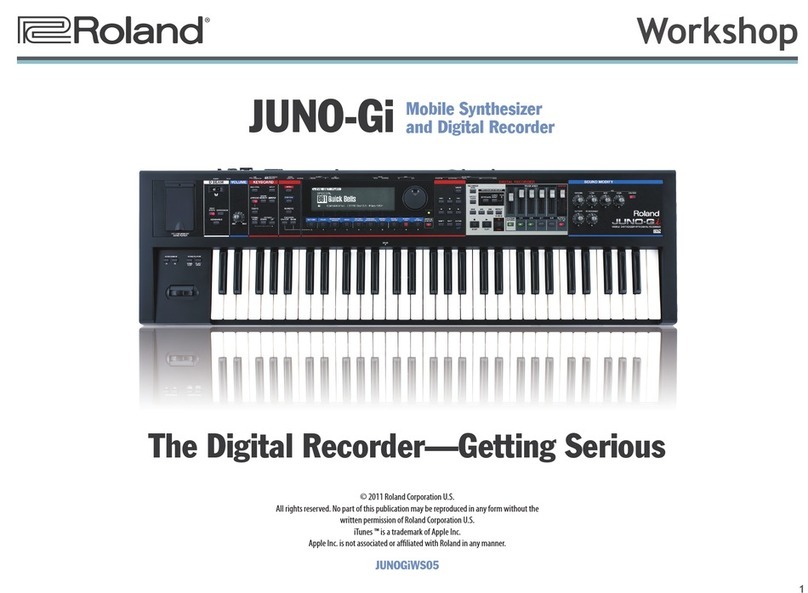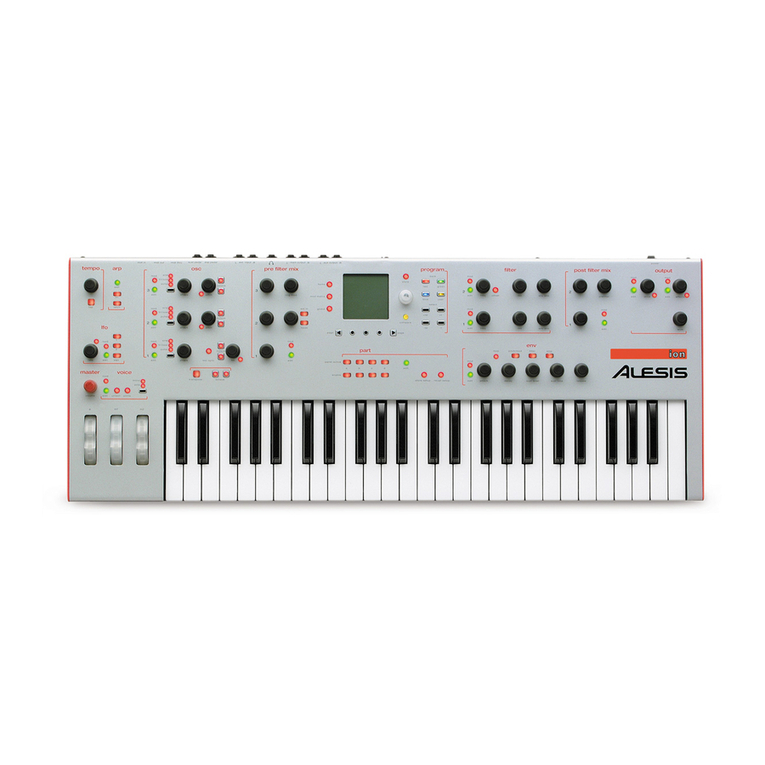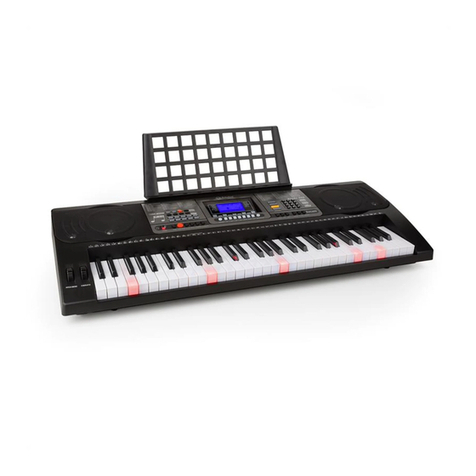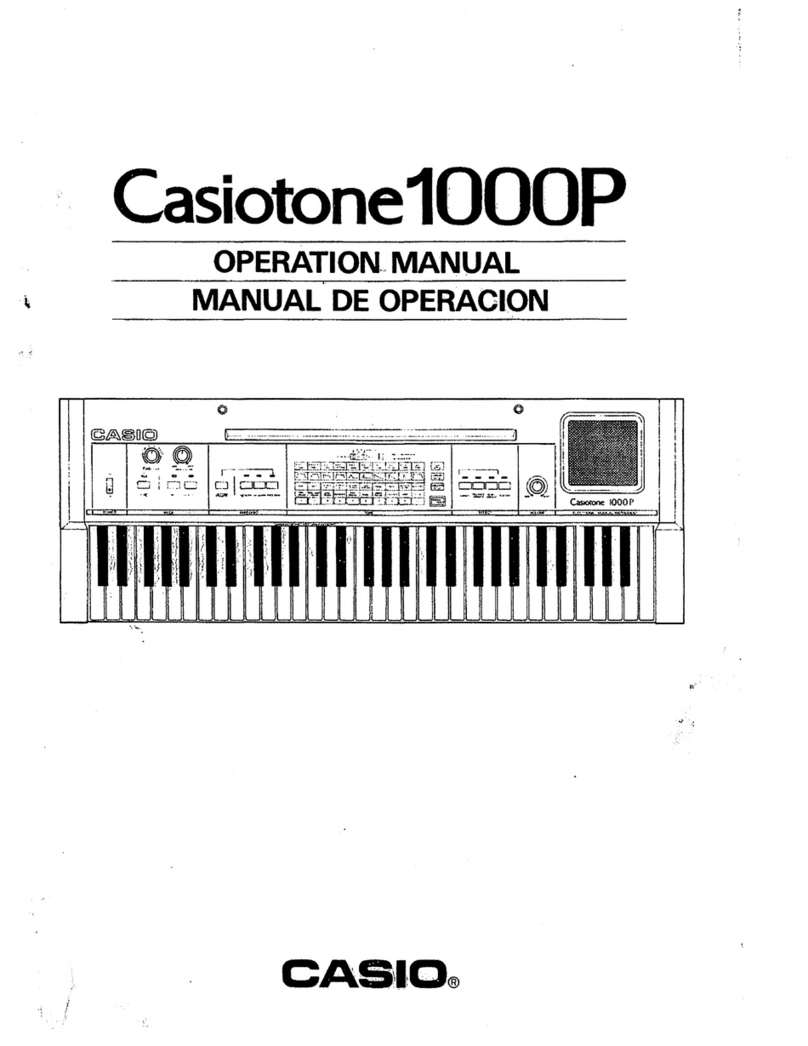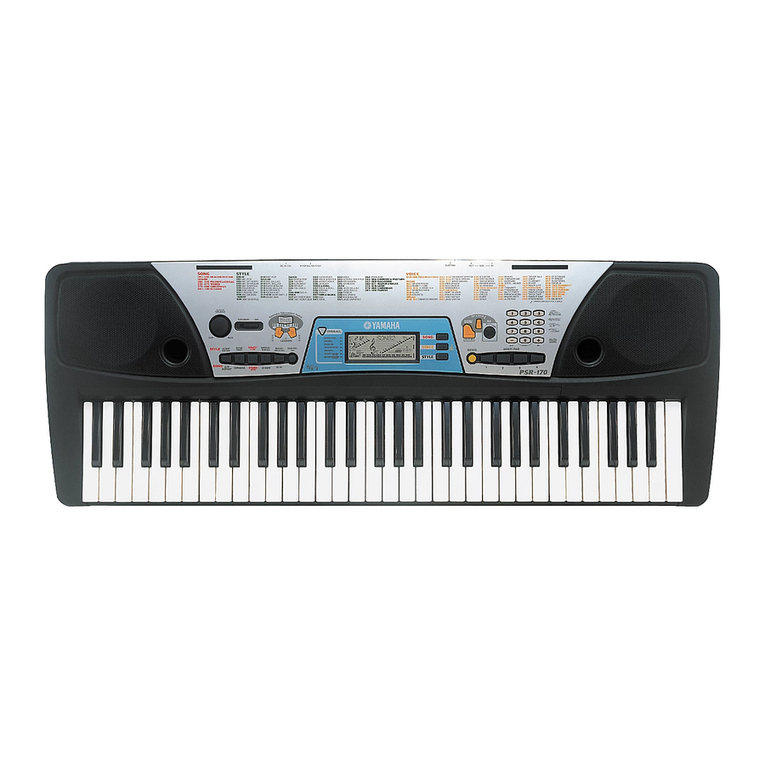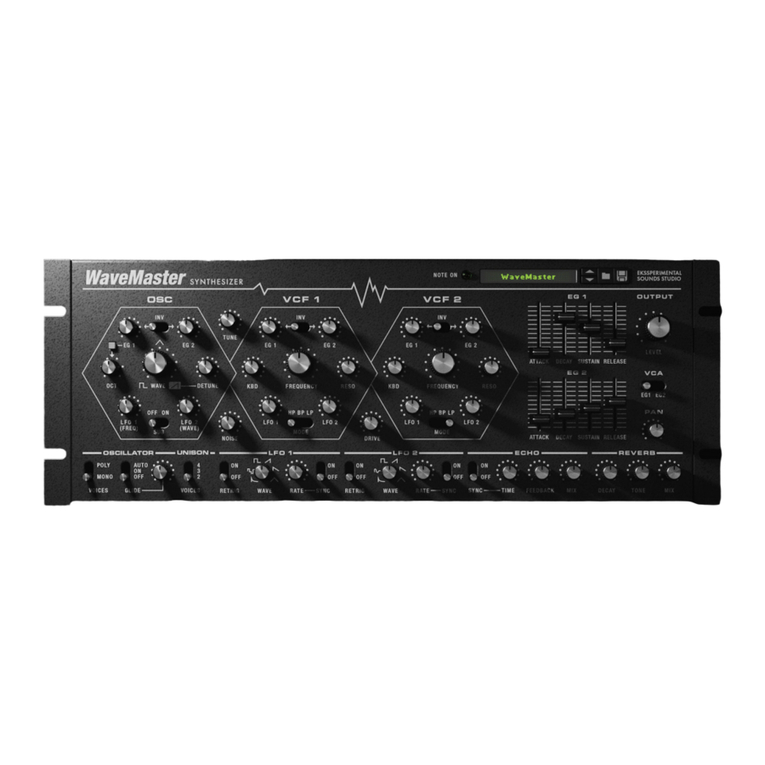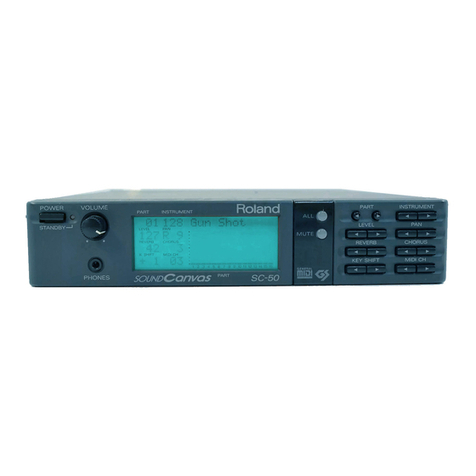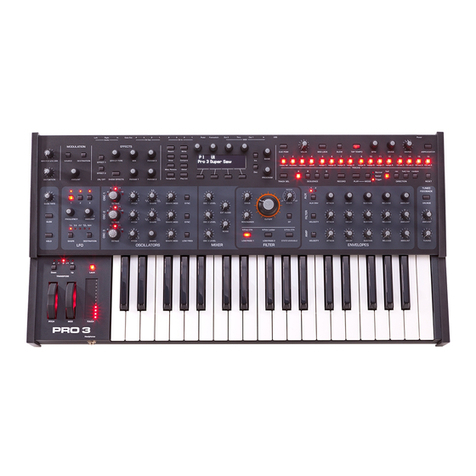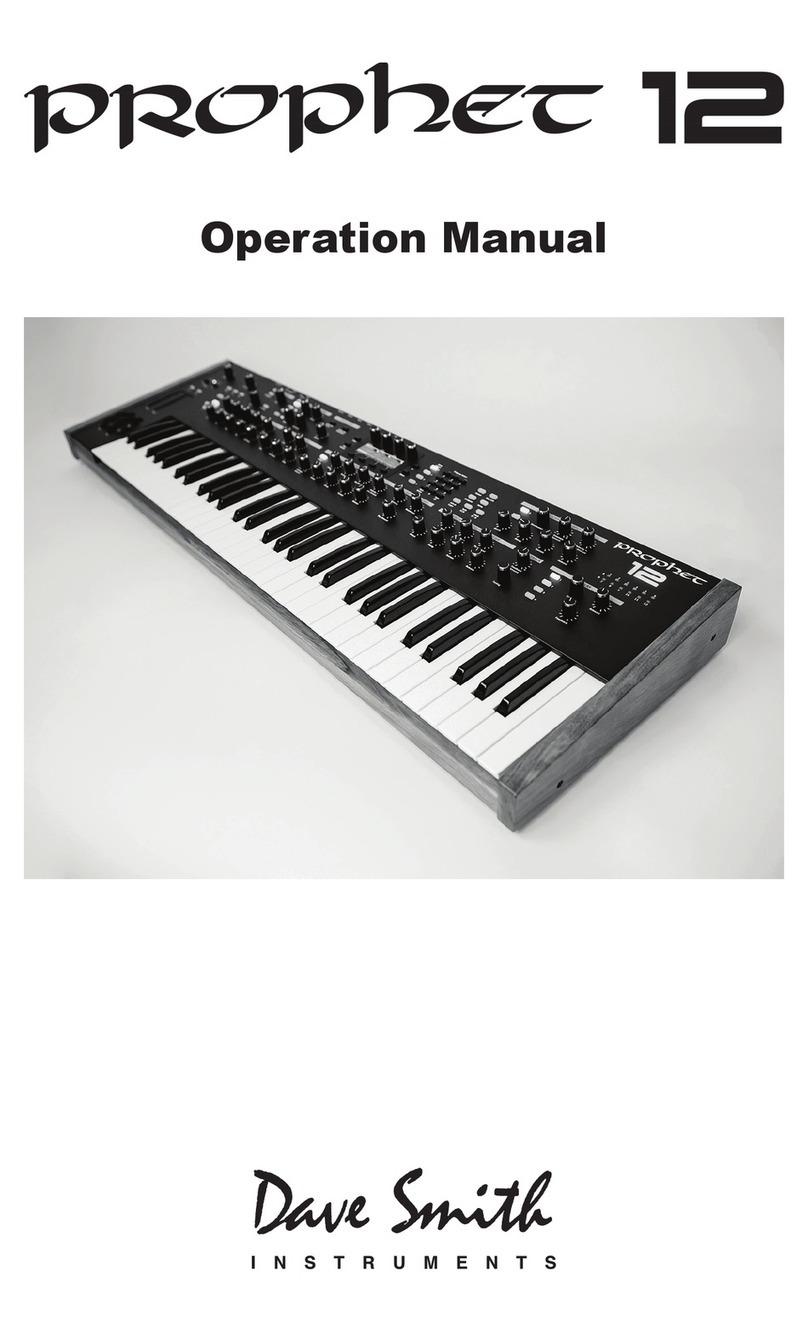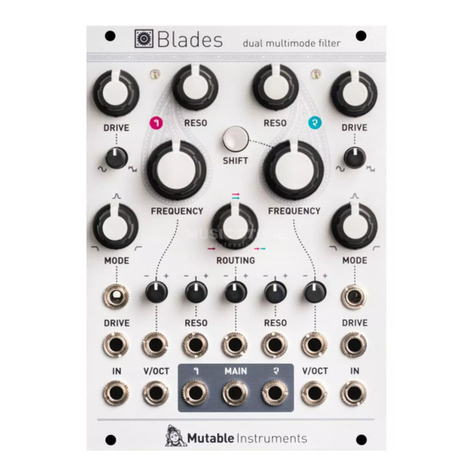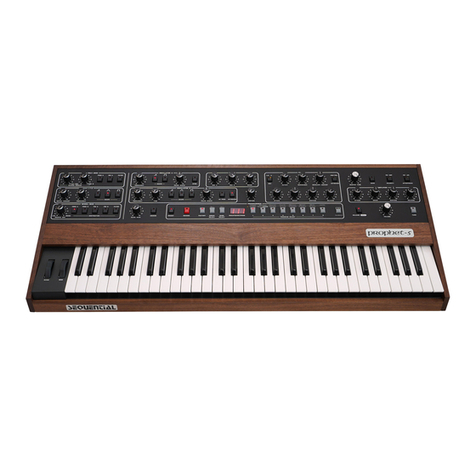Meris HEDRA 500 Series User manual

TABLE OF CONTENTS
SECTION 1 PG. 1 FRONT PANEL CONTROLS
SECTION 2 PG. 2 SIGNAL FLOW OVERVIEW
SECTION 3 PG. 3-4 CONTROLS IN DEPTH
3a - KEYS AND SCALES
3b- PITCH CORRECTION AND GLIDE CONTROL
3c - TIME DIVISION CONTROLS
SECTION 4 PG. 5 TRIGGERING PITCH VALUES WITH A MIDI KEYBOARD
SECTION 5 PG. 5 TEMPO
SECTION 6 PG. 5 FACTORY RESET
SECTION 7 PG. 5 TECHNICAL SPECIFICATIONS

1
SECTION 1 - FRONT PANEL CONTROLS
Key: Selects key for diatonic harmonies. Set to
max for chromatic shifting
Alt Function: Scale Type Select
(from Min to Max): Major, Minor, Melodic Minor,
Harmonic Minor, Double Harmonic,
Lydian Pentatonic, Minor Pentatonic
Bypass Status: Processes signal when
lit, passes dry signal entirely in analog
when unlit
Alt Function: Swell
Enable an automatic volume swell
based on the input
Microtune: Slightly detunes all three pitch shifted
voices
Alt Function: Pitch Correction and Glide
When the knob is between Min and Mid select
between No Correction, Loose Corrections, Strict
Correction. When knob is between Mid and Max
selects amount of glide
Pitch 1: Sets interval for the first pitch
shifted voice
Alt Function: Time Division 1
Sets a fraction of the main tempo for
the first pitch shifted voice
Tap: Sets the main tempo/delay time
Total available time = 520 msec
HOLD to access Alt Function:
Alt knob functions are available while this
button is being held
Mix: Adjusts the balance between Dry
and Wet signals
Alt Function: Delay Feedback
Controls delay feedback
Pitch 2: Sets interval for the second pitch shifted
voice
Alt Function: Time Division 2
Sets a fraction of the main tempo for second
pitch shifted voice
Pitch Feedback: When button is lit.
Pitch shifters are in the feedback loop
of the delay
Alt Functions: Half Speed
Enable the delay to run at half speed
Pitch 3: Sets interval for the third
pitch shifted voice
Alt Functions: Time Division 3
Sets a fraction of the main tempo for
third pitch shifted voice

2
The Hedra features 2 distinct delay line configurations:
1. Pitch Feedback On (button is lit):
In this mode, Hedra is configured to have one delay line (520 msec) with three inputs and one output. In this mode, the repeats
are recycled through the pitch shifters
2. Pitch Feedback Off (button is unlit):
In this mode, Hedra is configured to have one delay line (520 msec) with three inputs and one output. In this mode, the repeats
are mixed in after the pitch shifting.
SECTION 2 - SIGNAL FLOW OVERVIEW
SWELL
PITCH 1 PITCH 2 PITCH 3
TIME
DIVISION 1
TIME
DIVISION 2
TIME
DIVISION 3
DELAY LINE
FEEDBACK MIXER
SWELL
PITCH 1 PITCH 2 PITCH 3
TIME
DIVISION 1
TIME
DIVISION 2
TIME
DIVISION 3
O
U
T
P
U
T
S
I
G
N
A
L
O
U
T
P
U
T
S
I
G
N
A
L
I
N
P
U
T
S
I
G
N
A
L
I
N
P
U
T
S
I
G
N
A
L
F
E
E
D
B
A
C
K
F
E
E
D
B
A
C
K
FEEDBACK
MIXER
DELAY LINE
SWELL
PITCH 1 PITCH 2 PITCH 3
TIME
DIVISION 1
TIME
DIVISION 2
TIME
DIVISION 3
DELAY LINE
FEEDBACK MIXER
SWELL
PITCH 1 PITCH 2 PITCH 3
TIME
DIVISION 1
TIME
DIVISION 2
TIME
DIVISION 3
O
U
T
P
U
T
S
I
G
N
A
L
O
U
T
P
U
T
S
I
G
N
A
L
I
N
P
U
T
S
I
G
N
A
L
I
N
P
U
T
S
I
G
N
A
L
F
E
E
D
B
A
C
K
F
E
E
D
B
A
C
K
FEEDBACK
MIXER
DELAY LINE

3
Along with the front panel Key selection available on Hedra, hold the alt button and turn the Key knob to modulate
through and select among the following scales:
Major: Semi-tones: 2 - 2 - 1 - 2 - 2 - 2 - 1
Intervals: Root, Major 2nd, Major 3rd, Perfect 4th, Perfect 5th, Major 6th, Major 7th, Octave
Minor: Semi-tones: 2 - 1 - 2 - 2 - 1 - 2 - 2
Intervals: Root, Major 2nd, Minor 3rd, Perfect 4th, Perfect 5th, Minor 6th, Minor 7th, Octave
Melodic Minor: Semi-tones: 2 - 1 - 2 - 2 - 2 - 2 - 1
Intervals: Root, Major 2nd, MInor 3rd, Perfect 4th, Perfect 5th, Major 6th, Major 7th, Octave
Notes: When you ascend the melodic minor scale you use the above intervals, but depending on the composition, when you
descend you might want to use the intervals of the minor scale. Use an expression pedal with Hedra to choose how the scale
reacts to your playing.
Harmonic Minor: Semi-tones: 2 - 1 - 2 - 2 - 1 - 3 - 1
Intervals: Root, Major 2nd, Minor 3rd, Perfect 4th, Perfect 5th, Minor 6th, Major 7th, Octave
Double Harmonic: Semi-tones: 1 - 3 - 1 - 2 - 1 - 3 - 1
Intervals: Root, Minor 2nd, Major 3rd, Perfect 4th, Perfect 5th, Minor 6th, Major 7th, Octave
Lydian Pentatonic: Semi-tones: 4 - 2 - 1 - 4 - 1
Intervals: Root, Major 3rd, Tritone, Perfect 5th, Major 7th, Octave
Notes: This scale was inspired by the incredible music and playing of Marty Friedman and Jason Becker. One of the modes of the
Hirajoshi scale, Raga Amritavarshini, Malashri, Shilangi, and Batti Lydian.
Minor Pentatonic: Semi-tones: 3 - 2 - 2 - 3 - 2
Intervals: Root, Minor 3rd, Perfect 4th, Perfect 5th, Minor 7th, Octave
SECTION 3A - KEYS AND SCALES
MELODIC
MINOR
HARMONIC
MINOR
MAJOR
MINOR
SWELL
PITCH 1 PITCH 2 PITCH 3
TIME
DIVISION 1
OFF
MAX
TIME
DIVISION 2
TIME
DIVISION 3
DOUBLE
HARMONIC
EASTERN
PENTATONIC
MINOR
PENTATONIC
STRICT
CORRECTION
NO PITCH
CORRECTION
LOOSE
CORRECTION
I
N
P
U
T
S
I
G
N
A
L
O
U
T
P
U
T
S
I
G
N
A
L
F
E
E
D
B
A
C
K
P
I
T
C
H
G
L
I
D
E
A
M
O
U
N
T
0
1
7/8
5/61/6
A RANGE OF
MICRO TIME
DIVISIONS
3/41/4
2/31/3
5/83/8
1/2
FEEDBACK
MIXER
DELAY LINE

4
Hedra features 3 different pitch corrections settings or a
pitch glide amount as listed in the knob graphic below. When Loose
Correction is selected, the notes are forced into the current Key and
Scale but pitch bending is not removed from the input. When Strict
Correction is selected, the notes are forced into the current Key and
Scale but pitch bending is removed from the input.
The Alt control under each Pitch knob is a corresponding
Time Division. The Time Division Knobs sets the delay of each pitch
shifted voice by a fraction of the overall delay time set by the Tap
Tempo switch. Ex: a dotted eighth note is ¾ of a beat.
SECTION 3B - PITCH CORRECTION AND GLIDE CONTROL
SECTION 3C - TIME DIVISION CONTROLS
MELODIC
MINOR
HARMONIC
MINOR
MAJOR
MINOR
SWELL
PITCH 1 PITCH 2 PITCH 3
TIME
DIVISION 1
OFF
MAX
TIME
DIVISION 2
TIME
DIVISION 3
DOUBLE
HARMONIC
EASTERN
PENTATONIC
MINOR
PENTATONIC
STRICT
CORRECTION
NO PITCH
CORRECTION
LOOSE
CORRECTION
I
N
P
U
T
S
I
G
N
A
L
O
U
T
P
U
T
S
I
G
N
A
L
F
E
E
D
B
A
C
K
P
I
T
C
H
G
L
I
D
E
A
M
O
U
N
T
0
1
7/8
5/61/6
A RANGE OF
MICRO TIME
DIVISIONS
3/41/4
2/31/3
5/83/8
1/2
FEEDBACK
MIXER
DELAY LINE
MELODIC
MINOR
HARMONIC
MINOR
MAJOR
MINOR
SWELL
PITCH 1 PITCH 2 PITCH 3
TIME
DIVISION 1
OFF
MAX
TIME
DIVISION 2
TIME
DIVISION 3
DOUBLE
HARMONIC
EASTERN
PENTATONIC
MINOR
PENTATONIC
STRICT
CORRECTION
NO PITCH
CORRECTION
LOOSE
CORRECTION
I
N
P
U
T
S
I
G
N
A
L
O
U
T
P
U
T
S
I
G
N
A
L
F
E
E
D
B
A
C
K
P
I
T
C
H
G
L
I
D
E
A
M
O
U
N
T
0
1
7/8
5/61/6
A RANGE OF
MICRO TIME
DIVISIONS
3/41/4
2/31/3
5/83/8
1/2
FEEDBACK
MIXER
DELAY LINE

5
Using our MIDI I/O, Hedra accepts MIDI Note On and Off messages to hard tune the pitch shift voices to the exact notes
you play. Sending a single Note On Message into the Hedra will just tune the Pitch 1 value, sending two Note On Messages
will tune Pitch 1 and Pitch 2, and (as expected) sending three Note On Messages will tune all three pitch values. When Note Off
messages are received, the corresponding pitch value will mute. Here are a couple of creative possibilities that open up when
connecting a keyboard: turn Time Divisions to zero and the MIX Knob to max and the keyboard will turn your input audio into a
whole new playable instrument, use a DAW or MIDI Sequencer to play a 3 part song along with your dry signal, or turn the delay
and feedback to max and use a MIDI keyboard to build sonic sculptures one note at a time.
Holding down the “Bypass Switch” button (or R Top LED button) on power up resets all of the presets and all of the
global settings back to their original factory values. Once the reset is complete, simply recycle the power on the unit.
In Hedra you can set the tempo using one of the following tapping in quarter notes using the integrated Tap switch, MIDI
Beat Clock, or Tempo MIDI CC. (An updated manual including MIDI information will be provided soon.)
SECTION 4 - TRIGGERING PITCH VALUES WITH A MIDI KEYBOARD
SECTION 5 - TEMPO
SECTION 6 - FACTORY RESET
SECTION 7 - TECHNICAL SPECIFICATIONS
Conversion 24 bit A/D and D/A
DSP 32 bit floating point
Sample Rate 48000 Hz
SNR -116 dB Signal to Noise Ratio (typical)
Frequency Response 20Hz-20kHz
Bypass 100% Analog Bypass
Linking Stereo and surround linkable
I/O Burr-Brown precision balanced input and output drivers

6
Federal Communications Commission Radio Frequency Interference Statement
This equipment has been tested and found to comply with the limits for a Class B digital device, pursuant to part 15 of the FCC Rules. These limits are designed to provide reasonable protection against harmful interference
in a residential installation. This equipment generates, uses and can radiate radio frequency energy and, if not installed and used in accordance with the instructions, may cause harmful interference to radio communications.
However, there is no guarantee that interference will not occur in a particular installation. If this equipment does cause harmful interference to radio or television reception, which can be determined by turning the equipment
off and on, the user is encouraged to try to correct the interference by one or more of the following measures:
—Reorient or relocate the receiving antenna.
—Increase the separation between the equipment and receiver.
—Connect the equipment into an outlet on a circuit different from that to which the receiver is connected.
—Consult the dealer or an experienced radio/TV technician for help.
This device complies with Part 15 of the FCC Rules. Operation is subject to the following two conditions: (1) this device may not cause harmful interference, and (2) this device must accept any interference received, including
interference that may cause undesired operation.
This equipment requires shielded interface cables in order to meet FCC class B limit.
Any unauthorized changes or modifications not expressly approved by the party responsible for compliance could void the user’s authority to operate the equipment.
Table of contents
Other Meris Synthesizer manuals

